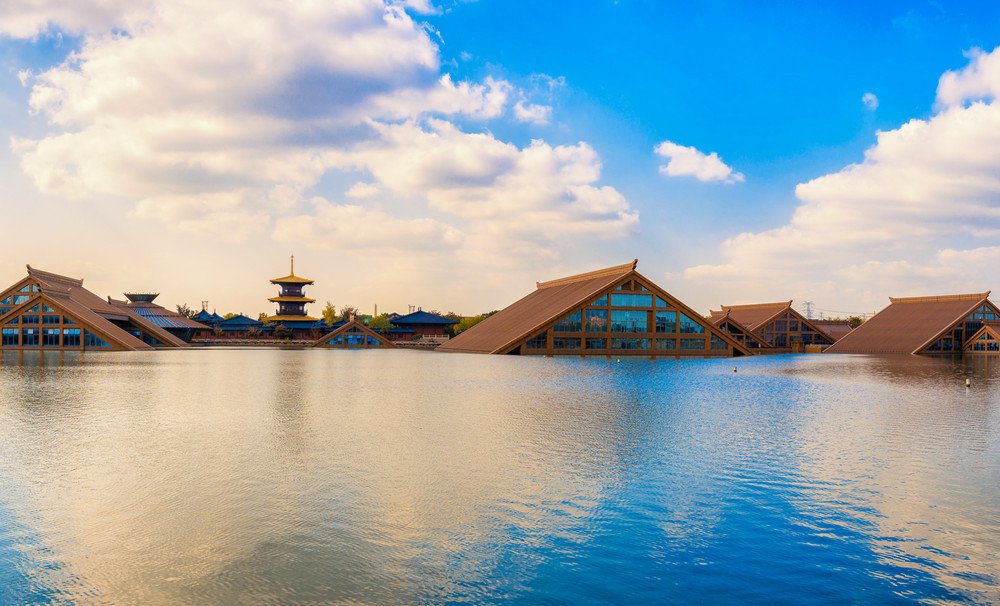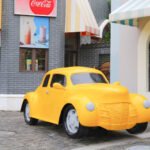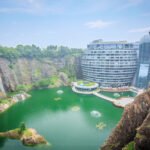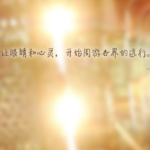Duration: 3 days, Time: June, Cost per person: 3000 yuan, Companions: Friends, Activities: Culinary delights, Photography, Free travel. The author visited the following places: Songjiang Guangfulin Site, Shanghai Happy Valley, Sheshan National Forest Park, Zuibaichi, Shanghai Chenshan Botanical Garden, Tianma Mountain, Sheshan Observatory, Zhiye Zen Temple. Published on 2020-06-10 at 04:23.

Preface: When Shanghai is mentioned, what comes to mind are the Bund and the towering skyscrapers of the city. Shanghai, an international metropolis, amazes us with its foreign exposition along the Bund and the skyscrapers in Lujiazui. At dusk, the dazzling neon lights highlight the splendor of the Oriental Pearl Tower. The Bund Square is bustling with people, filled with laughter, and the car lights blend with the lights of the high-rise buildings, creating a continuous, unending picture scroll. The various foreign-style buildings glisten under the illumination, as if made of gold, seemingly telling us the history of Shanghai. However, have you seen Songjiang in Shanghai? Known as the root of Shanghai, Songjiang is not only steeped in history but also boasts beautiful scenery that captivates visitors. The largest archaeological project in Shanghai, the Guangfulin Site, is home to the most fascinating underwater museum. A visit to the Guangfulin underwater museum allows you to travel through millennia and experience the charm of this city. At Shanghai Happy Valley, search for that long-lost joy and leave all worries behind, indulging in the fun here. Breathe in the fresh air at Sheshan National Forest Park, where the mountain paths are lined with lush greenery, and the panoramic view of Sheshan unfolds as you reach the summit. The most classical garden in Shanghai, Zuibaichi, allows you to walk through the park and experience the beauty of classical Jiangnan gardens. Yunjian Granary, a repurposed old granary, transforms into an artistic check-in spot. From the blue elves seen on television to experiencing the search for happiness with the blue elves in person. Shanghai Chenshan Botanical Garden is the largest botanical garden in the East China region and the second botanical garden in Shanghai. Regain the childlike smile and find joy in Happy Valley. The first stop in Songjiang, Shanghai, is Shanghai Happy Valley. I have visited Happy Valleys in other places before, but this time at Shanghai Happy Valley, I felt the park was quite large. Early in the morning, many people had already lined up to enter, and the entrance to Happy Valley was filled with tourists. I observed that young people mostly came here to play, as the attractions inside are quite thrilling and more suitable for the younger crowd, although there are also attractions for children. Upon entering the main gate of Happy Valley, we first arrived at the Happy Time spot to check-in. There are many attractions to enjoy here, and many tourists were already queuing up. It turned out they were waiting to ride the roller coaster. As I approached, I noticed that the roller coaster here was different from those seen elsewhere; it was made of wooden blocks, not very high, and relatively enjoyable. However, do not underestimate this roller coaster; it can still be a bit scary when you ride it.
The speed is too fast. When climbing to a certain height, one suddenly falls from a high place to the lowest point and then slides away quickly. Those with acrophobia are still advised not to go up and play. Walking further inside, we come to the old Shanghai block. Today’s Shanghai is a cosmopolitan city with extremely modern features yet without losing traditional Chinese characteristics. The prosperous Shanghai everywhere shows its unique charm. The fascinating Bund with its old-fashioned Western architecture and the modern skyscrapers in Pudong complement each other. The sound of morning readings at Xujiahui University can be heard early. Incense curls up at the Jade Buddha Temple. Here in old Shanghai, people can recall the old dreams of old Shanghai in the 1920s and 1930s. While the rhythm of modern disco and the ubiquitous Internet cafes bring people back to modern civilized life in the 21st century. In Happy Valley, one can still feel the old Shanghai architecture of the 1920s and 1930s. Coming to Happy Valley is to seek happiness. Here is the source of happiness. Seeing there are so many fun projects inside. Seeing two bubble masters performing. Watching so many bubbles floating in the air all at once. The colorful bubbles are so beautiful under the illumination of light. One can also interact on site. Operating with tools by oneself can also see many bubbles coming out. Seeing several children next to them watching the performance. They are all very interested in the beautiful bubbles. Crossing the bridge, one can hear the screams of tourists on the pendulum ride in the distance. This is one of the most popular amusement items for young people. Friends who enter the park early in the morning directly run here to experience it. The extremely fast speed suddenly swings the pendulum ride to the highest point and then drops it down. The whole person feels terrible. Just listening to the bursts of screams one can know how crazy it is. Feel happiness in Happy Ocean. Here there are more amusement items mainly for children. There are many amusement items painted in blue, just like the color of the sea. Seeing many parents bringing their children here to play. Water speedboats, Ocean No.1, Ocean Star and other amusements are deeply loved by children. Summer is here. This should be one of the favorite places for children to play. One can play with water here. A good place to escape the summer heat. In Gold Mine Town, there are fun projects such as Gold Mine Waterfall and Mine Adventure. Seeing a very distinctive motorcycle model and a statue of a cowboy riding a horse. There are also some restaurants nearby. When you are tired from strolling, you can sit here, have something to eat and drink some beverages before continuing. The entire park is relatively large. One can spend a whole day here. If one wants to play every project once, it seems that one day is not enough. Going to Sheshan National Forest Park and breathing fresh air. Sheshan National Forest Park has beautiful mountains and lush forests. It is rich in animal and plant resources. Especially the bamboo shoots produced in the mountains are famous for their orchid-like fragrance.
Sheshan National Forest Park is located in the southwest suburban area of Songjiang District, Shanghai. The park is known for its lush pine and bamboo forests, and beautiful scenery. In addition to the frequently visited East Sheshan and West Sheshan, there are 12 peaks including Tianma Mountain, Phoenix Mountain, and Xiaokunshan. Excluding man-made hills, the Sheshan mountain range is the only ‘true’ mountains in Shanghai, with Tianma Mountain, at an elevation of 98.2 meters, naturally becoming the highest peak in Shanghai. As you walk up the mountain path, you will encounter the Sheshan Peak Bell Tower, with lush trees on both sides and a high coverage of green vegetation. However, there are some mosquitoes on the mountain, so it is recommended to bring mosquito repellent when hiking. From the top of Sheshan, the entire Sheshan scenery unfolds before your eyes, with many villas visible. These villas must be quite valuable in Shanghai, surrounded by trees at the foot of the mountain. The residents living nearby are fortunate, as they can climb Sheshan National Forest Park every day, breathe fresh air in the forest, and take evening walks. At the top of the mountain, there is an ancient Sheshan Observatory, but unfortunately, it was not open to the public when we visited, leaving us with a bit of regret for not being able to see the inside. We look forward to visiting again in the future. In front of the observatory entrance, there are many stone railings carved with various constellation patterns, such as the Andromeda constellation, indicating the connection with astronomy. Halfway up the mountain, there is an ancient tower with stone carvings in front, including stone horses and a cute stone sculpture that looks like a cat sitting in front of the tower, watching it. This place can be visited on weekends or on ordinary days, especially during the hot summer, it is also a good place to escape the heat. You can not only see the beautiful scenery of the entire Sheshan area but also breathe the fresh air in the forest. The food at the Forest Hotel satisfies the taste buds. After climbing down from Sheshan National Forest Park, we were very hungry. There is a hotel called the Forest Hotel right across from the park entrance. Unexpectedly, the food in the hotel is also open to the public, which can be considered as hidden delicacies within the hotel. We had lunch there directly, and surprisingly, the price-performance ratio was very high, something we usually don’t know. We ordered several dishes, all of which were very tasty, and some dishes were reminiscent of childhood memories for Shanghai locals. The boiled white chicken may look similar to ordinary chicken, but the taste is different. It tastes better than ordinary chicken, mainly because this restaurant chooses a different breed of chicken, which is tenderer and more delicious. A new way of making fish soup, tender and delicious, the fish soup is as white as milk, and it tastes really good, very fresh, and the whole pot was finished in one go.
Kourou rice was the first time I’ve ever had such a dish. It was absolutely delicious. The greasy fat of the braised pork perfectly blended into the rice, which also had a touch of green vegetables, similar yet distinct from the salty rice in our Minnan area. When eating, a slight stir makes it non-greasy. The deep-fried pork’s feet were crispy on the outside and tender on the inside, with the skin turning flaky while the meat retained its original flavor. The taste of the sauced duck was also delightful. After lunch, I casually visited the rooms here. The Forest Hotel offered half the usual price during this period, which was truly cost-effective. The rooms were spacious, bright, and stepping onto the balcony offered a view of the Sheshan Mountain opposite, facing the Sheshan Park across the street. The transportation here was convenient, and parking was also easy if you were driving. Located at the foot of Sheshan, it had a beautiful and quiet environment. Overall, the value for money was high. The Guangfulin Site, the magical underwater museum: ‘A decade of Shanghai is seen in Pudong, a century in Puxi, and a millennium in Songjiang.’ Songjiang is the birthplace of Shanghai’s history and culture. As the ‘root of Shanghai,’ Songjiang’s history and culture are uniquely charming due to its profound heritage. As early as 6000 years ago in the Neolithic Age, the indigenous people of Songjiang thrived in the area of today’s Guangfulin, fishing, hunting, and farming. By 4000 years ago, the ancestors from the Yellow River basin, the Wangyoufang people, migrated to Guangfulin and, together with the local indigenous people, created the ‘Guangfulin culture,’ a blend of northern and southern civilizations, thus enriching Shanghai’s roots. Most people come to Guangfulin to see the magical underwater museum. Stepping into the Guangfulin underwater museum allows you to travel through thousands of years and feel the charm of this city. Half of the museum is submerged underwater. On a vast expanse of water, houses seem to grow out of the water, floating on the surface. The buildings with sharp, knife-cut edges and corners appear to be experiencing a flood, with houses seemingly submerged under the water, only exposing triangular ridges. This is the Guangfulin underwater cultural exhibition hall. At the entrance, you first see the site where this area was excavated, with lifelike archaeologists recreated before your eyes. Going down another level, you first encounter the Neolithic Age and then gradually move into modern times, fully reflecting the process of the roots of Shanghai. The Fuling Pagoda is a landmark building in the ruins park, visible from afar with its towering spire. The Tang-style three-story ancient square pagoda is different from the hexagonal and octagonal pagodas of other periods. The Fuling Pagoda is a religious art museum. Adjacent to the Fuling Pagoda is the Zhiye Zen Temple, which is a Buddhist cultural exhibition hall. The Zhiye Zen Temple was rebuilt in memory of the good deeds of Master Zhiye, who healed and rescued people.
Zhiye Zen Temple offers vegetarian noodles at 20 yuan per serving. If it happens to be lunchtime, you can have a serving inside. White walls, black tiles, and horse-head walls create an illusion as if one has returned to the beautiful scene of Hongcun. In front of the parking lot, there is a huge screen wall. In the center of the screen wall is a large brick carving that vividly and truly reflects the life scenes of the ancient people of Fulin, the ancient kilns of Fulin, and the commerce of Fulin. There are also statues of Xu Xiake, Chen Zilong and others, with vivid figures and scenery. As well as historical carvings of the dragon boat on which Emperor Kangxi of the Qing Dynasty traveled south and disembarked here. These lifelike reliefs help people understand the history and culture of Guangfulin. Shanghai Zuibaichi, one of the most famous classical gardens in the south of the Yangtze River. Zuibaichi is one of the famous classical gardens in the south of the Yangtze River and a tourist attraction in Shanghai. Counting from the predecessor of this garden, it has a history of more than 900 years. The park covers an area of 76 mu. The park is full of ancient trees, densely covered with pavilions, and there are many historical sites. Zuibaichi has a history of more than 300 years and still preserves ancient buildings such as halls, pavilions, pavilions, boats, and waterside pavilions, and maintains the style of classical gardens in the south of the Yangtze River during the Ming and Qing Dynasties. Its curved railings, horizontal thresholds, winding corridors and curved paths are antique. On the day I went, it just happened to rain heavily. Browsing the famous classical garden in Shanghai in the rain is also a new experience. The heavy rain dresses up the whole park with a unique scenery. Walking in Zuibaichi Park, there are sceneries everywhere. If you have been to the Humble Administrator’s Garden in Suzhou, then you will feel the charm of classical gardens in the south of the Yangtze River. Here, you don’t have to go to Suzhou to experience classical garden art on the spot. When the owner built the garden, he thought that if the great poet Li Bai were reincarnated and came here to roam, he would definitely be intoxicated by the scenery on the pond and be intoxicated by the garden beside the pond. So let’s call the garden on the pond ‘Zuibaichi’. He specifically thought that in the Song Dynasty, there was a poet named Han Qi who was a high-ranking official and was very intoxicated with the poems of Bai Juyi, a poet of the Tang Dynasty. He built an ancient classical hall named ‘Zuibaichang’ in his hometown Anyang, Henan. Gu Dashen also admired Bai Juyi very much and was often intoxicated by the beautiful artistic conception of Bai Juyi’s poems. So he imitated Han Qi’s practice and named his own garden ‘Zuibaichi’. The name ‘Zuibaichi’ is novel and unique, with profound meaning and beautiful artistic conception, making people yearn for it. After several rises and falls and several disasters, Zuibaichi finally ushers in a vibrant spring. Yunjian Granary, transformed into a literary check-in place. Yunjian Granary is located at 327 Songhui East Road. It was originally a grain warehouse and factory that had been abandoned for many years. The total area of the base is 98 mu. There are many single-story sloping roof granaries built one after another from the 1950s to the 1990s. The old granary has been transformed into a new cultural check-in landmark. Every brick and tile still retains the marks of time. The transparent glass exterior wall exudes the literary atmosphere of the new era.
Today, the old granaries have been transformed into a new cultural landmark in Songjiang. Some exhibition halls are already open, while others are under preparation. Upon entering Yunjian Granary, a massive trumpet-shaped iron structure comes into view. Although many rooms are still closed, and some are under renovation, it is anticipated that this place will become a popular cultural and artistic spot in the future.
The authentic taste of traditional Shanghai cuisine is a must-try for any traveler. Visiting ‘Xiao Yeshu’ restaurant, which offers local specialties, is a great experience. The restaurant is quite spacious and focuses on the traditional flavors of Shanghai, integrating the taste of Shanghai cuisine into daily life. The moment you step in, you are drawn to the delicacies on offer. The ordering area lists the day’s dishes, and just looking at them makes you want to dig in. The restaurant’s signature dish is a type of pancake filled with crab meat, resembling a crab shell in appearance. It is incredibly flaky and tender, with a refreshing aroma. Another signature dish is a local specialty fish, which is large and has tender, delicious meat and a sweet, clear soup. The sauce duck is the best I’ve ever tasted. It is a Shanghai dish that can be found in various restaurants, but each has its unique flavor. A refreshing and crunchy salad made from watermelon rind is also a highlight.
The Smurf-themed amusement park in Shanghai is a nostalgic memory for several generations. The classic work ‘The Smurfs’ by Belgian cartoonist Peyo entered China in the 1980s and has become a shared childhood memory. The Asia-Pacific’s first Smurf-themed amusement park has brought the animated scenes into reality, with classic characters such as Papa Smurf, Smurfette, Brainy Smurf, Clumsy Smurf, and the evil Gargamel transformed into characters within the park. When I entered the Smurf-themed amusement park, I was captivated by the architectural environment. Upon entering the main gate, there is a huge blue arched hall in the center for children to play. Further inside, following the arrows on the floor, you reach the Smurf area, where adorable Smurf statues appear in every corner. Gargamel’s forest area is located at the entrance of the Smurf area, with a dense forest isolating modern vibes and allowing visitors to immediately immerse themselves in the fairy-tale world created by the park. In the village area, visitors will find themselves in the village where the Smurfs live, with large and small mushroom houses as their homes, experiencing the life scenes from the animation. Entering Gargamel’s house, visitors will take on the role of Smurf rescue team members, going through various challenges to rescue the Smurfs captured by Gargamel.
The outdoor Maoxianwang Area and Smurfs Area are connected by two dynamic cinemas. The Maoxianwang Area covers eight children’s amusement projects, including flight cinema, 6D cinema, children’s experience hall, earthquake hall, etc. In addition, the park also plans elf-themed float parades, performing arts shows, food peripherals and more. It is a great place to take children to play. The most beautiful park in Shanghai, Chenshan Botanical Garden. Chenshan Botanical Garden is currently the largest comprehensive botanical garden in Shanghai, covering an area of 207 hectares and located at the foot of Chenshan Mountain in the Sheshan mountain range in Songjiang District. Shanghai has a flat terrain and lacks mountains. Although Chenshan Mountain is only 71.4 meters above sea level, it is still very rare. According to records of Dong Qichang in the Ming Dynasty, Chenshan Mountain “is to the southeast of all mountains and is second to the position of Chen”, hence its name. The scenic area has designed a complete tourist route. The central exhibition area includes 26 specialized botanical gardens such as the East China flora garden, quarry garden, rare botanical garden, and aquatic botanical garden. If you visit them one by one, one day is not enough. In different seasons, there are flowers in bloom. Cherry blossoms and peach blossoms in spring, lotus and hibiscus in summer, chrysanthemums and dogwood in autumn, wintersweet and orchids in winter. There are more flowers that are not common and whose names cannot be recalled. Flowers accompany you all year round. Every time you come to Chenshan Botanical Garden, you will be in a good mood. Climbing up the mountain along the steps, Chenshan Mountain has dense vegetation. There is an observation deck on the mountain, from which you can overlook the entire botanical garden. The Chenshan Tower on the top of the mountain is towering and conspicuous. If you come to Chenshan Botanical Garden in summer, the hot outdoors will make you desperate. The greenhouse area is the place you most want to go and should go. The greenhouse area of the botanical garden is very large and contains several gardens such as the xerophytic botanical garden and rare botanical garden. The temperature here is suitable all year round. Summer is a colorful season. Accommodation recommendation: New Century Grand Hotel Shanghai Songjiang. During this trip to Songjiang, Shanghai, I stayed at New Century Grand Hotel Shanghai Songjiang. It is relatively close to the surrounding attractions and the transportation is more convenient. The room is relatively large with a huge transparent floor-to-ceiling window, offering a panoramic view of the distant scenery. For me who often needs to work, having a desk is really very useful. The photos taken on the same day can be uploaded and shared online. The lighting in the room is warm-toned and relatively warm. The area of the bathroom is also relatively large. There is also a bathtub and a dry-wet separated bathroom. The delicious food in the hotel should not be missed either. That night we had dinner in the Chinese restaurant of the hotel. Osmanthus-flavored spare ribs, beef, and lobster are all good. The way of cooking lobster is different from what I usually eat. The lobster meat is tender and smooth. Beef is also one of my favorite delicacies. In conclusion, Shanghai is an international metropolis. For more than a hundred years, Shanghai has always been the center of Chinese commerce, a gathering place of wealth, and a business card that China shows to the world.
The brilliance of this city lies in its seamless blend of the past and the present, and its adeptness at creating trendy elements. What was once a vast sea field in Pudong has now been replaced by maglev trains and one of the most international airports. Songjiang, known as the root of Shanghai, holds an abundance of culture that is worth our slow and meticulous exploration. The exquisite and delicious Shanghai dim sum, the graceful and charming Shanghai women, and the enchanting local dialect all contribute to the unique flavor of Shanghai that intoxicates at the first taste.






